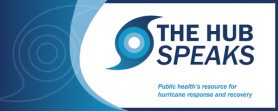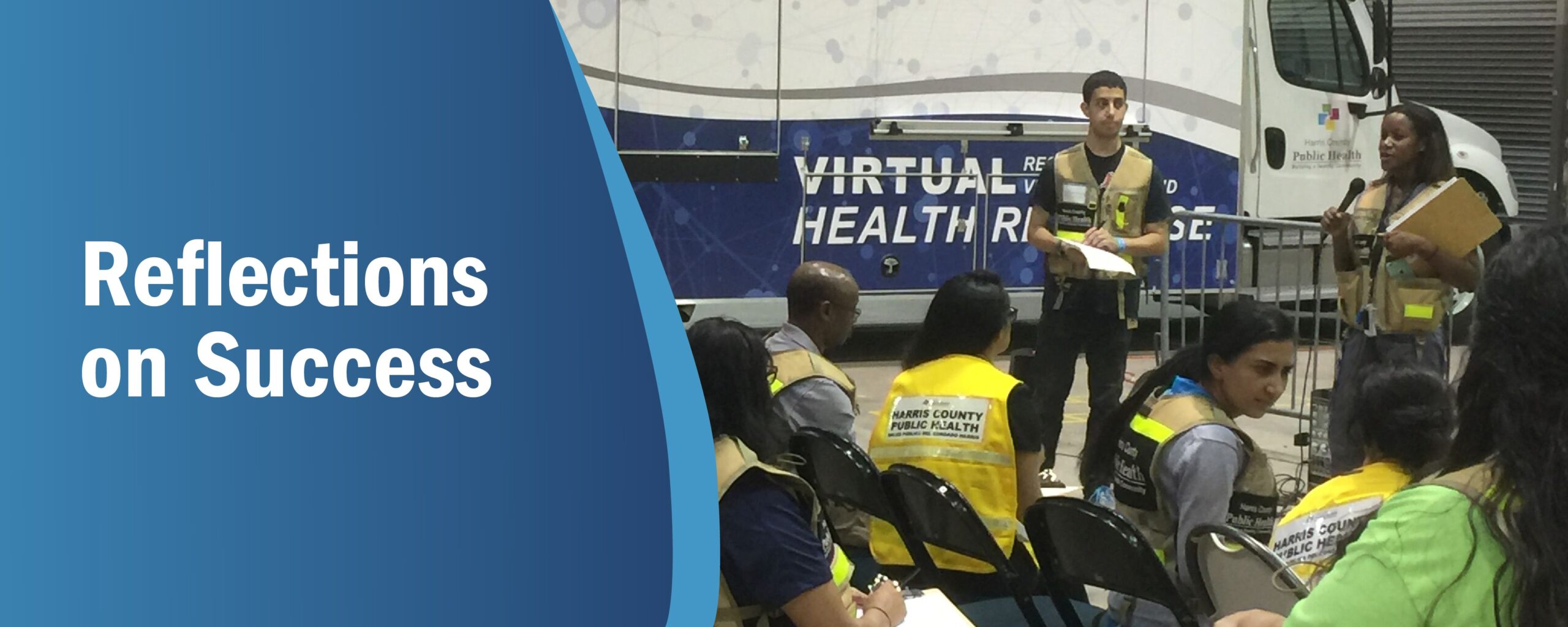Reflections on Success: Hurricane Response Hub
- By: National Network of Public Health Institutes
- Date
The Hurricane Response Hub (HRH) initiative was a two and a half year collaboration between the National Network of Public Health Institutes (NNPHI) and the Centers for Disease Control and Prevention (CDC) National Center for Environmental Health. In response to the devastating hurricanes of 2017—Harvey, Irma, and Maria—five technical assistance centers (TACs) were established and led by four public health institutes and one public health training center. This initiative sought to develop and to deliver training, provide technical assistance, and enhance information sharing to support the ongoing hurricane recovery in Georgia, Louisiana, Texas, Florida, and Puerto Rico.
Through the HRH initiative, each Hurricane Response Hub TAC established long-lasting partnerships that supported successful environmental and occupational health-related recovery activities and measures that enhanced overall hurricane preparedness. Here are some of those successes from the project.
The Georgia Hurricane Response TAC, housed within the Rollins School of Public Health at Emory University, worked to bring together leading public health and preparedness officials to enhance storm resilience capacity in Georgia. Emory’s work improved Georgia’s storm resilience capacity through building a multi-agency workgroup, a virtual WebEOC (Emergency Operations Center), Disaster Reports Dashboard, and a Power Outage Resource Toolkit.
The inter-professional, multi-agency workgroup served as a consortium of experts that guided the development and implementation of resources, training, and system enhancements devised through the TAC. Over 50 individuals were active members of five workgroups with expertise ranging from regional healthcare coalitions to state and local health department preparedness and response staff.
Georgia’s WebEOC system enables healthcare facilities to enter and view data related to a disaster. This tool was intended to provide essential information about healthcare facilities’ capacity and available resources; however, due to the COVID-19 pandemic, this tool was quickly redirected to track critical COVID-19 health data. Currently, the WebEOC system tracks and provides key healthcare facility data to include bed allocation, resources and supplies, and COVID-19 census data. Utilized by both the Georgia Department of Health and the Governor’s Office, the WebEOC system has been acknowledged as a tremendous asset for the state.
Other innovations include a Disaster Reports Dashboard that serves as a situational awareness tool for epidemiologists and other public health emergency preparedness staff to view data from multiple sources in one central location and a Power Toolkit, which is an emergency asset distributed to healthcare facilities and/or shelters during power outages, enabling health care workers to care for community residents who require electricity-dependent medical equipment.
Louisiana
New Orleans, the home of the Louisiana Hurricane Response Hub TAC which is housed within the Louisiana Public Health Institute, experienced significant amounts of rainfall and flooding from Hurricane Harvey in 2017. Given the damage that the area experienced and its vulnerability to future storms, the TAC sought to assess the environmental and occupational health needs of the public health and emergency preparedness workforce.
The initiative identified a considerable gap in the area of responder mental health first aid, which led them to develop an instructor certification program. Recognizing the impact that hurricanes and COVID-19 have had on the residents of New Orleans, the TAC sought to increase the community’s capacity to assist individuals experiencing a mental health crisis. Four TAC staff members were certified as mental health first aid instructors, after which they could provide train-the-trainer sessions to community-based organizations. As of February 2021, four mental health first aid instructors and 48 mental health first aid providers have been certified. The TAC is currently working towards scaling up its mental health first aid training capacity in anticipation of partnering with additional organizations.
Texas
The flooding caused by Hurricane Harvey damaged more than 200,000 homes and forced the evacuation of thousands of resident in the Houston metro area. To aid the recovery efforts, the Texas Hurricane Response TAC, located within the Texas Public Health Institute, focused on responder training. The Texas TAC created eight training courses that focused on hurricane preparedness, response, and recovery for the public health and emergency response workforce. These on-demand learning courses are delivered through the Tulane School of Public Health and Tropical Medicine learning management system.
The Texas TAC also hosted ECHO tele-mentoring sessions to bring together community organization members and public health leaders to learn and share knowledge on critical hurricane preparedness issues. One ECHO series, “Hurricane Season in the Context of COVID-19,” afforded participants the opportunity to focus on preparing for possible hurricane season evacuations during the COVID-19 pandemic. Through the HRH initiative, the Texas TAC accomplished their goal of providing relevant trainings and learning opportunities to better prepare the public health, emergency response, and healthcare responder workforces for response to and recovery from future hurricanes and other disasters.
Florida
Focused on building its community’s workforce capacity, the Florida TAC, founded by the Florida Institute for Health Innovation, collaborated with the National Oceanic and Atmospheric Administration (NOAA) and others to create trainings relevant to the environmental and occupational health aspects of hurricane recovery. The NOAA training showcased the Coastal Flood Exposure Mapper Tool, and included a demo and training exercise focused on storm surge and health impacts. The goal of this training was to provide an overview of how communities can use data layers to create user-defined maps that show populations, critical facilities, and natural resources that could be potentially exposed to damaging coastal flooding. This tool can be employed by both the public health workforce and emergency response personnel to identify and prioritize vulnerable hotspots across the state.
The thirty-two participants who attended the training now have access to a new tool for assessing coastal flooding hazards. They also learned how to communicate with local organizations about the tool and how to use these maps for engagement with vulnerable community members. This collaborative effort highlighted the variety of health-related issues that citizens of South-Florida are facing due to the increasing threat of hurricanes due to climate.
Puerto Rico
After Hurricanes Irma and Maria left a trail of devastation on the island, Puerto Rico struggled through a difficult recovery. The Puerto Rico Public Health Trust established a Hurricane Response Hub TAC to support the delivery of public health services and rebuild the capacity of the public health and emergency response workforces. The projects and resources produced over the course of the project included an ECHO series, suicide prevention trainings, efforts to build resilience and redundancy in emergency communications, and a Community Assessment in Public Health Emergency Response (CASPER).
Through collaboration with the Puerto Rico Department of Health, Ponce Health Sciences University, and the Centers for Disease Control and Prevention, the Puerto Rico TAC developed and deployed a modified CASPER focused on hurricane preparedness and COVID-19. The objectives of this project were to obtain baseline COVID-19 prevalence data, detect asymptomatic cases of COVID-19, and assess community disaster and emergency readiness. A newly trained workforce of CASPER team leads, interviewers, and nurses deployed throughout Puerto Rico conducting household surveys and collecting blood samples to determine the island’s seroprevalence. The results from the interviews and testing provided key insight regarding knowledge of COVID-19 and community disaster preparedness.
The Puerto Rico TAC hosted a series of ECHO sessions that focused on COVID-19 and disaster preparedness, which reached more than 200 community members and led to the creation of a network of community leaders who can better collaborate on public health crises. The TAC also partnered with the Puerto Rico Department of Health team to offer a series of workshops focused on helping clinical and public health professionals identify danger signs and risk factors that could trigger suicide attempts and how to best prevent them. Over 1,567 participants attended this series of workshops. Additionally, to build resilience and redundancy in emergency communication, the Puerto Rico TAC acquired KP4 radios, antennas, and solar panels for installation throughout the 10 regions of the island which will help maintain future disaster communications.
The greatest and farthest reaching accomplishment of the Puerto Rico TAC was building death certification capacity across the island. In the aftermath of Hurricane Maria, national attention was focused on the accuracy of the hurricane-related death count as official numbers did not reflect reports from communities and residents. The TAC convened a workgroup to develop a bilingual training death certification curriculum in Spanish and English that has been adopted by all medical schools on the island. More than 500 participants have completed the course to date. An administrative order signed by Puerto Rico’s Secretary of Health now requires all physicians renewing their professional license to complete the course. The TAC and their partners became the national leader in providing death certifiers, from medical schools students to working healthcare providers, training on how to accurately report disaster-related mortality.
How You Can Get Involved
To get more information about our Emergency Preparedness, Response, & Recovery Team, visit here.
More Articles Related to The Hub Speaks


 Subscribe To Our Communications
Subscribe To Our Communications